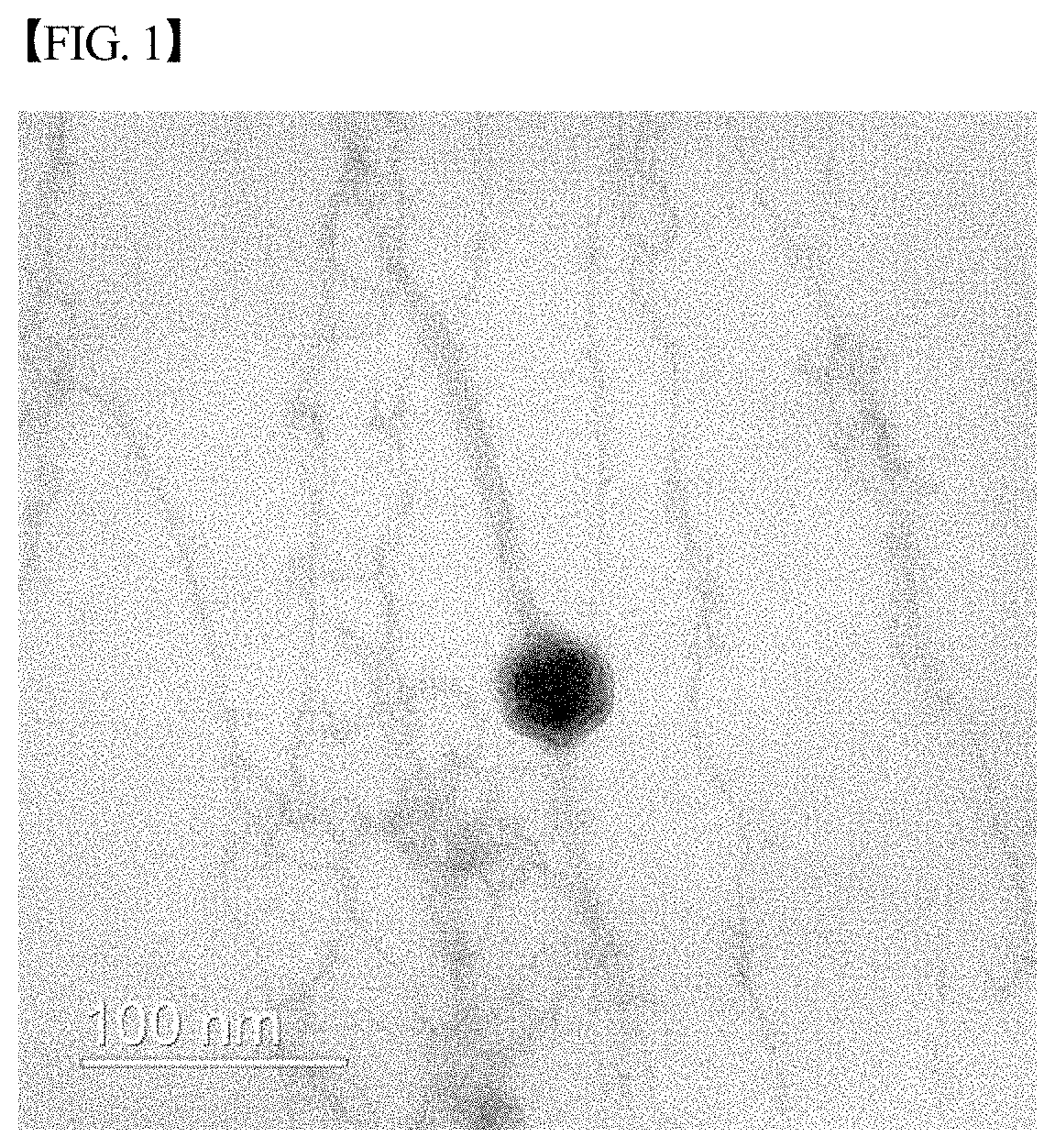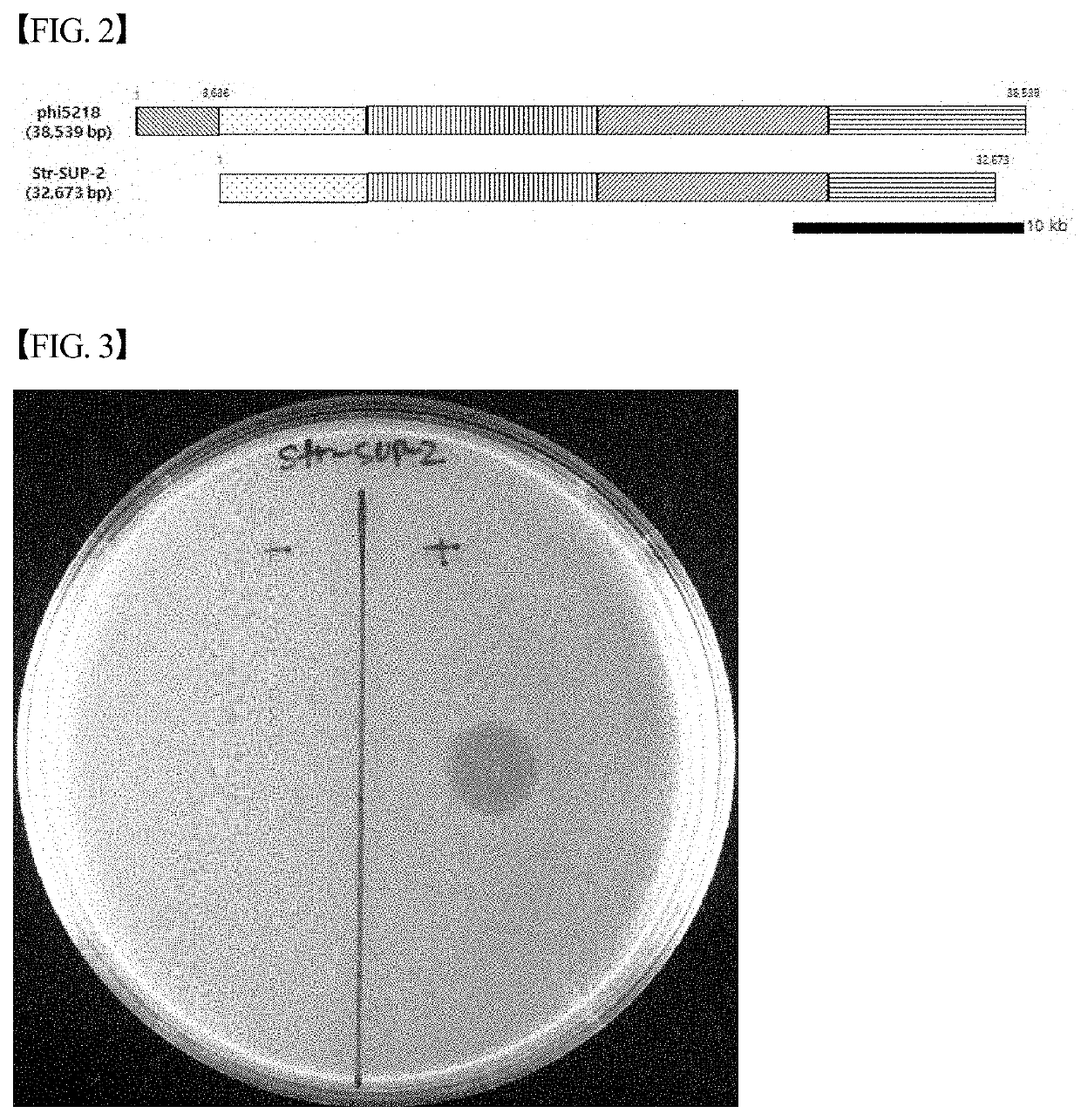Novel streptococcus suis bacteriophage str-sup-2, and use thereof for inhibiting proliferation of streptococcus suis strains
a technology of streptococcus suis and bacteriophage, which is applied in the direction of viruses/bacteriophages, antibacterial agents, biocide, etc., can solve the problems of increasing the incidence of bacteria resistant to such antibiotics, urgent need for other methods besides antibiotics, and serious economic loss to the pig farming industry. , to achieve the effect of reducing the immunity of animals, reducing side effects, and high specificity of streptococcus suis
- Summary
- Abstract
- Description
- Claims
- Application Information
AI Technical Summary
Benefits of technology
Problems solved by technology
Method used
Image
Examples
example 1
Isolation of Bacteriophage Capable of Killing Streptococcus suis
[0034]Samples collected from nature were used to isolate a bacteriophage capable of killing Streptococcus suis. Here, the Streptococcus suis strains used for the bacteriophage isolation were obtained from the Korean Collection for Type Cultures (Accession number: KCTC 3557).
[0035]The procedure for isolating the bacteriophage is described in detail herein below. The collected sample was added to a THB (Todd Hewitt Broth) medium (heart infusion, 3.1 g / L; peptone, 20 g / L; dextrose, 2 g / L; sodium chloride, 2 g / L; disodium phosphate, 0.4 g / L; sodium carbonate, 2.5 g / L) inoculated with Streptococcus suis at a ratio of 1 / 1,000, followed by shaking culture at 37° C. for 3 to 4 hr. After completion of culture, centrifugation was performed at 8,000 rpm for 20 min and the supernatant was recovered. The recovered supernatant was inoculated with Streptococcus suis at a ratio of 1 / 1000, followed by shaking culture at 37° C. for 3 to...
example 2
Separation and Sequence Analysis of Genome of Bacteriophage Str-SUP-2
[0040]The genome of the bacteriophage Str-SUP-2 was separated as follows. The genome was separated from the bacteriophage suspension obtained using the same method as described in Example 1. First, in order to remove DNA and RNA of Streptococcus suis included in the suspension, 200 U of each of DNase I and RNase A was added to 10 ml of the bacteriophage suspension and then allowed to stand at 37° C. for 30 min. After being allowed to stand for 30 min, in order to inactivate the DNase I and RNase A activity, 500 μl of 0.5 M ethylenediaminetetraacetic acid (EDTA) was added thereto, and the resulting mixture was then allowed to stand for 10 min. In addition, the resulting mixture was further allowed to stand at 65° C. for 10 min, and 100 μl of proteinase K (20 mg / ml) was then added thereto to break the outer wall of the bacteriophage, followed by reacting at 37° C. for 20 min. Thereafter, 500 μl of 10% sodium dodecyl ...
example 3
Evaluation of Killing Ability of Bacteriophage Str-SUP-2 for Streptococcus suis
[0044]The killing ability of the isolated bacteriophage Str-SUP-2 for Streptococcus suis was evaluated. In order to evaluate the killing ability thereof, the formation of clear zones was observed using a spot assay in the same manner as described in Example 1. A total of 10 strains that had been isolated and identified as Streptococcus suis by the present inventors or obtained from the KCTC or Korea Veterinary Culture Collection were used as Streptococcus suis strains for evaluation of killing ability. The bacteriophage Str-SUP-2 had the ability to kill a total of 8 strains, including KCTC 3557, among 10 strains of Streptococcus suis, which was the experimental target. The representative experimental result is shown in FIG. 3. Meanwhile, the ability of the bacteriophage Str-SUP-2 to kill Bordetella bronchiseptica, Enterococcus faecalis, Enterococcus faecium, Streptococcus mitis, Streptococcus uberis and ...
PUM
| Property | Measurement | Unit |
|---|---|---|
| pH | aaaaa | aaaaa |
| volume ratio | aaaaa | aaaaa |
| transparent | aaaaa | aaaaa |
Abstract
Description
Claims
Application Information
 Login to View More
Login to View More - R&D
- Intellectual Property
- Life Sciences
- Materials
- Tech Scout
- Unparalleled Data Quality
- Higher Quality Content
- 60% Fewer Hallucinations
Browse by: Latest US Patents, China's latest patents, Technical Efficacy Thesaurus, Application Domain, Technology Topic, Popular Technical Reports.
© 2025 PatSnap. All rights reserved.Legal|Privacy policy|Modern Slavery Act Transparency Statement|Sitemap|About US| Contact US: help@patsnap.com


